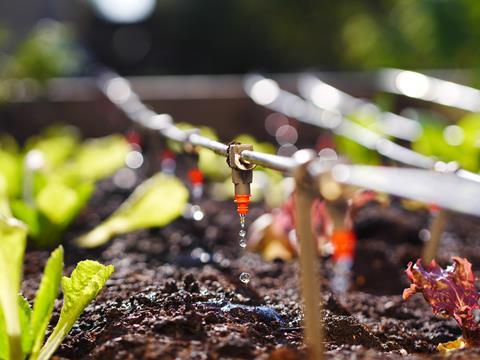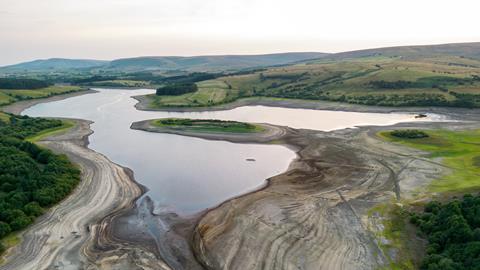Dr Rachel Helliwell, director of the Hydro Nation International Centre and CREW at the James Hutton Institute, explains why water scarcity is such a serious issue in Scotland and what is being done to address it
How would you assess the country’s water security right now?
Eastern Scotland continues to feel the strain of prolonged dry conditions, with key catchments like the Almond and Tweed now elevated to Alert status, and Orkney, Thurso, and Clyde newly classified under Early Warning.
While the northwest has seen more consistent rainfall, it has largely missed the regions most in need, and river flows in parts of Fife and Aberdeenshire remain critically low.
With conditions shifting weekly, it’s vital that all sectors – agriculture, industry, energy, and communities – stay informed to support effective planning and water stewardship. The SEPA Water Scarcity Report offers a robust, science-led overview based on near real-time monitoring and expert evaluation. Keeping up to date helps ensure that decisions are timely, proportionate, and responsive to local conditions.
How do you see the balance between the water needs of residents, the need to protect rivers and the natural environment, and the needs of farming to produce food?
Scotland may be famous for its lochs and rain-soaked landscapes, but the long-held assumption that it is a water-rich country is increasingly being challenged. Contrary to popular belief, water scarcity is emerging as a serious and growing issue, with significant implications for communities, industries, and the environment.
At the James Hutton Institute, recent modelling by Shaini Naha indicates that the frequency of drought conditions in Scotland could double by 2050 and the duration of droughts may increase three to five-fold. This shift, driven by climate change and increased pressure on resources, poses particular challenges, especially for people who rely on private water supplies, which are often the most vulnerable during extended dry periods.
The implications extend beyond households. Scotland’s food and drink sector, a vital part of the national economy, is already feeling the strain. Whisky distilleries, for instance, are at risk of production shutdowns during the summer months – not just due to lower water availability, but also because rising water temperatures during the summer months can be an issue.
New areas of concern are also emerging. As Scotland moves toward a low-carbon economy, green hydrogen production – which requires a significant high-quality and reliable water supply – is placing additional demand on the resource. The convergence of domestic, industrial, and environmental needs is creating a more complex and competitive water landscape.
Water scarcity reduces river flows, leading to higher water temperatures and lower oxygen levels, which can stress aquatic ecosystems and disrupt natural life cycles. Species like Atlantic salmon are particularly vulnerable, as low flows and warm water can block migration, reduce spawning success, and increase mortality. Citizen science evidence from the past century shows that Scottish rivers are warming.
Low river levels result in low dilution of pollutants that can also have a negative impact on ecology.
To help navigate this challenge, the Scottish Environment Protection Agency (SEPA) developed Scotland’s first National Water Scarcity Plan. This strategic framework outlines how the country will manage water resources before and during periods of prolonged dry weather, with the aim of balancing environmental protection and socioeconomic needs.
What practical steps would you like to see taken to improve this?

As part of the Scottish Government’s Strategic Research Programme, CREW plays a critical role in delivering robust, policy-relevant evidence to inform decision-making across government and its key delivery partners, including SEPA, Scottish Water, and NatureScot etc.
This ensures that responses to water-related challenges are grounded in the latest science and tailored to Scotland’s unique environmental and policy context.
To improve water scarcity resilience, a combination of practical, science-based, and policy-driven actions is needed. Together, these measures can help ensure we adapt effectively to increasing water scarcity risks while protecting ecosystems and supporting economic resilience.
Key steps include:
- Improve water monitoring and early warning systems
- Enhance water efficiency across sectors
- Change behaviours
- Prioritise catchment-based management
- Restore natural water systems
- Strengthen regulation and planning
- Secure supplies for vulnerable communities
- Incentivise innovation for climate resilience
- Raise public awareness and behaviour change.
Is there currently a disconnect between water policy and science?
Scotland benefits from a strong science–policy interface, supported by the Scottish Government’s Strategic Research Programme, which fosters a two-way exchange of knowledge: policy priorities help shape research (“policy push”), while research institutes and universities provide timely, evidence-based insights on emerging challenges.
Mechanisms like the CREW Science Policy Fellowship strengthen this connection by providing an opportunity for Scotland’s water research community to summarise and advocate for what they perceive to be the most critical science challenges.
However, water scarcity is raising new, complex questions, particularly around increasing demand for water to support green hydrogen production. This issue spans environmental regulation, economic planning, and societal impact, highlighting the need for cross-policy coordination to ensure sustainable decision making.
While science-policy engagement is strong, responding effectively to such multifaceted challenges will require even closer collaboration and strategic foresight.

Is the farming industry doing enough to preserve and recycle water? What more would you like to see done?
Scotland’s farmers are increasingly on the front lines of climate change, facing more frequent and intense hydrological extremes, from floods to droughts. The spring of 2024 brought cool, wet conditions that delayed planting and caused poor crop germination due to excess water at the wrong time.
In sharp contrast, recent months have seen very low rainfall, resulting in reduced river flows and groundwater reserves, further impacting crop yields and putting pressure on livestock systems.
While these conditions may seem opposite, floods and droughts demand many of the same resilience measures. The key is working with nature to retain water in the landscape – in both wet and dry periods.
Climate-positive land management such as cover cropping, organic mulching, and improved soil management not only prevent erosion but also enhance the soil’s ability to absorb and store water. Nature-based solutions within catchments and on farms – such as creating ponds and wetlands in naturally waterlogged areas or installing low-cost leaky dams – can play a vital role in storing water during wet periods and slowing runoff during storms, reducing peak flows and downstream flood risk.
These measures also allow water to infiltrate the soil and recharge groundwater, supporting resilience during dry spells. By managing land to cope with both floods and droughts, farmers can build long-term climate resilience into their systems. As water demand increases, especially during prolonged dry periods, these approaches should be aligned with irrigation planning and abstraction licensing, ensuring water use remains sustainable and responsive to changing conditions.
It’s also important to recognise that nature-based solutions are often designed to deliver multiple co-benefits beyond managing hydrological extremes. In addition to reducing flood risk and improving drought resilience, these measures can improve water quality, enhance biodiversity, sequester carbon, and contribute to landscape aesthetics.
When located near communities, features like wetlands or ponds can also provide valuable recreational spaces, offering opportunities for walking, wellbeing, and public engagement with nature. This multifunctionality makes nature-based solutions a cost-effective and holistic approach to climate adaptation and sustainable land management.
There is growing recognition that effective climate adaptation lies in managing water as a whole system, beyond rainfall and reservoirs, by restoring natural processes at the farms and catchment scale. Integrating nature restoration and climate-smart practices into agricultural practices is no longer just an environmental ambition; it is becoming essential for ensuring the long-term viability of food production in the face of a changing climate.
The recent Efra committee report said the water sector is failing. Would you agree?

While there is evidence of issues, it would be overly simplistic to apply a blanket judgment across the entire sector. There are notable examples of innovation, strong partnership working, and policy coherence that are driving positive change, particularly in areas such as nature-based solutions, climate adaptation, and science-policy collaboration (for example, through CREW in Scotland).
These demonstrate that the sector is capable of evolving and delivering long-term value.
However, there are also systemic challenges that cannot be ignored.
Scotland, like many nations, is grappling with the challenges of ageing water infrastructure, much of it dating back to the Victorian era. But the path forward isn’t solely about more hard engineering – more reservoirs, pumping infrastructure, or canals.
Instead, it requires a fundamental shift in how we value, use, and manage water. This includes embracing behavioural change, resource recovery, and circular approaches such as treating wastewater and recycling greywater.
We need to prioritise multi-functional solutions that deliver multiple benefits, such as nature-based interventions that support both water quantity and quality while enhancing biodiversity and carbon sequestration.
Beyond managing hydrological extremes, there is a growing need to address emerging environmental contaminants – from microplastics and pharmaceuticals to personal care products and pesticides – that are now routinely detected in Scotland’s aquatic environments.
Tackling these issues will require source control/behavioural change, rapid innovation in water monitoring and surveillance, with new treatment technologies needing to be tested, operationalised, and scaled up quickly.
At the same time, the sector must reckon with its climate impact. The water industry is among the largest contributors to greenhouse gas emissions, due to energy-intensive treatment processes. New, low-emission wastewater treatment technologies are essential to accelerate decarbonisation.
Scottish Water’s commitment to becoming net zero by 2040 is ambitious and sets a benchmark, but delivering on this goal will require coordinated action across policy, research, regulation, and industry.
Responsible water use is a big issue which will require societal/behavioural and economic change: average residential consumption is about 178 L per person per day in Scotland, significantly influenced by lower metering rates and high domestic and industrial demand.
England and Wales: Average is around 140 L per person per day, but dips to 127 L/day for metered households, highlighting how billing structure drives consumption.
What’s needed now is a systems-level response, one that blends technological innovation, regulatory reform, public engagement, and natural solutions to create a resilient, low-carbon, and sustainable water future for Scotland. I wouldn’t say the water sector is failing: it needs mechanisms/governance structures/proper resourcing etc to adapt at pace to the climate emergency.




